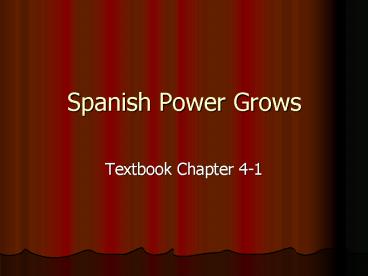Spanish Power Grows - PowerPoint PPT Presentation
1 / 14
Title:
Spanish Power Grows
Description:
Spanish Power Grows Textbook Chapter 4-1 Growth of Spanish Power Section Vocabulary Hapsburg Empire: Holy Roman Empire and the Netherlands (Germany) Absolute monarch ... – PowerPoint PPT presentation
Number of Views:298
Avg rating:3.0/5.0
Title: Spanish Power Grows
1
Spanish Power Grows
- Textbook Chapter 4-1
2
Growth of Spanish Power
3
Section Vocabulary
- Hapsburg Empire Holy Roman Empire and the
Netherlands (Germany) - Absolute monarch ruler with complete authority
over the government and the lives of the people - Divine right belief that the authority to rule
comes directly from God - Armada naval fleet
4
Charles V2 crowns?
- 1516 grandson of Ferdinand and Isabella,
Charles I, inherits the Spanish throne - 1519 Charles also inherits the throne of the
Holy Roman Empire (Germany) - Charles takes the name Charles V and is more
commonly known this way
5
Problems with having two empires
- Religion Charles was a Catholic and fought to
suppress Protestantism - Ottoman Empire advances and occupation of
Southeastern Europe - Eventually, the empire becomes too difficult to
rule and Charles gives up the thrones. - His brother becomes Holy Roman Empire, while his
son, Philip becomes the king of Spain.
6
The task of ruling two scattered empires proved
impossible for Charles V.
7
Philip II expanded Spanish influence and power
during his 42-year reign. One of his main goals
was to advance Spanish Catholic power in
Europe. He fought many wars to this end.
8
Philip II solidifies power
- Centralizing Power reigned as an absolute
monarch who believed in divine right and desired
to defend the Catholic Reformation - Battles in the Mediterranean and the Netherlands
Philip was forced to fight many battles in order
to defend Catholicism in these Protestant or
Muslim areas
9
Philip reigned as an absolute monarch, with
complete authority over Spain.
He devoted most of his time to governing and made
every part of the government responsible to
him Philip asserted that he ruled by divine
right. He believed his right to rule came from
God.
10
Philip fought wars in the Mediterranean and the
Netherlands. His goal was to keep the Ottomans at
bay. In 1571 (Battle of Lepanto), Spain defeated
an Ottoman fleet off the coast of Greece.
Philip also battled rebels in the Netherlands
for many years.
Protestants there opposed Philips efforts to
crush their faith.
11
The Defeat of the Spanish
- The Armada sails against England Queen
Elizabeth I of England was Philips most powerful
Protestant enemy. - She also encouraged the attacks of sea captains
on Spanish ships to steal gold. - In 1588, Philip assembled a huge armada to invade
England (130 ships, 20,000 men, and 2,400 pieces
of artillery). - However, the smaller English ships
- were able to out maneuver those
- of Spain and they defeated the
- Spanish fleet.
12
An Empire Declines
- The defeat of the Spanish fleet marked the
beginning of the decline of Spanish power. - Philip IIs successors were not good rulers.
- Economic problemscostly overseas ventures
(Americas), neglect of farming and commerce in
favor of gold and silver - Depletion of workforce due to the expulsion of
Muslims and Jews from Spain - In the 1600s and 1700s, other European fleets
arose and surpassed Spains power
13
Prior to the sunset of Spains power, however, a
golden age of culture occurred.
- This golden age, fostered by Philips patronage
of the arts, lasted from 1550 to 1650. - Painters
- El Greco painted beautiful works of religious
imagery and vivid portraits of Spanish noble. - Diego Velazquez- vivid portraits of Spanish
royalty - Writers
- Lope de Vega- wrote 1500 plays, witty comedies
and romances - Miguel de Cervantes completed Don Quixote,
considered Europes first modern novel. It told
the comic adventures of a landowner who imagines
himself to be a medieval knight.
14
Don Quixote









![[PDF]DOWNLOAD Seasonal Spanish Food: 125 Simple Recipes to Bring Home the Flavors of Spain PowerPoint PPT Presentation](https://s3.amazonaws.com/images.powershow.com/10080120.th0.jpg?_=20240719015)





















